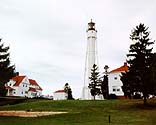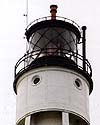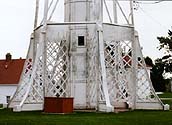 |
 |
 |
|
| Sturgeon Bay Ship Canal Light Station | Seeing The Light |
|
|
|
|
Historical
Information As early as 1890 maritime interests led by Joseph Harris Sr., the editor of the Door County Advocate, had raised their voices calling for the construction of a brighter and taller shore-based light to augment the existing aids. Responding to the groundswell of public opinion, the Lighthouse Board petitioned Congress for the funds to construct a light near the keeper's dwelling in 1890. With the Federal Government's purchase of the ship canal in 1893, authority for the canal was turned over to the U.S. Corps of Engineers, and stewardship of the Lights thus became the official responsibility of the Lighthouse Board. Concurrent with their approval of the canal's purchase, Congress also authorized the construction of a shore light. However, Congress did not follow-up with the $20,000 appropriation required for the project until March 1895. Although test borings were made at the site the following year, work did not actually begin on the tower until the lighthouse tender Amaranth docked in Sturgeon Bay with the necessary supplies for construction on May 13, 1898.
Work began with the excavation and pouring of a huge twenty-nine foot square block of concrete with a depth of eight feet. At the center of this foundation, a seventy-eight foot tall double-walled steel cylinder, eight feet in diameter, was raised. Supported by eight latticed buttresses, the structure was secured to the concrete pad using two-inch diameter bolts some ninety inches in length, which had been cast deep into the concrete. At the top of the cylinder a twelve foot diameter watch room was installed. The watch room was in turn capped by a cast iron lantern room approximately eighteen feet tall and eight feet wide. While most lantern rooms were multi-sided, this lantern room was circular in conformation, with specially curved glass custom manufactured for the application in France. The inclusion of diamond astragals gave the lantern room a unique and dignified appearance. While the lantern room was painted black, atypically, the entire structure was given a fresh coat of brown paint.
After some study of the situation, Lighthouse officials believed that the installation of guy wires would eliminate the vibration. Thus, early that December, four six-foot square concrete blocks were sunk in the ground around the tower, and wires with turnbuckles were strung from eyebolts in the blocks to the tower cylinder a few feet below the watch room. The rework was completed at the end of December and the light was tested once again. Unfortunately, the vibration problem had not been eliminated. Additionally, it was found that the warmth of the sun expanded the guy wires on one side of the tower, causing the tower to list in the opposite direction. When the turnbuckles were adjusted to straighten the structure, the vibration reappeared. Dismayed, the Lighthouse Engineers departed from Sturgeon Bay for the season, intent on identifying an improved solution. While the vibration problem still unsolved, the light was officially placed into service on March 17, 1899, with the Third Order Fresnel lens exhibiting alternate red and white flashes. Almost immediately, complaints about the effectiveness of the light as a daymark were heard from the maritime community. The complaints indicated that during daylight hours, the reddish-brown color of the structure made it difficult to discern from the landscape behind. To rectify the situation, the tower was given a coat of white paint during the summer of 1900. While the tower thus became more visible, the vibration problem continued unabated, and the keepers continued to fight a battle to keep the clockworks operating at the prescribed speed of rotation. The district lampist was dispatched to the station, but despite his best efforts to adjust the mechanism, the vibration continued to play havoc with the clockworks.
In
the original design, the entire weight of the watch room and lantern
room had been born by the single slim central cylinder. Determining that
this top-heavy configuration itself was the root cause of the problem,
the decision was made to install six steel legs around the central stair
tube. The necessary components were designed and fabricated over the following winter, loaded onto a lighthouse tender, and shipped to Sturgeon Bay along with a construction crew early in 1903. Doubtless all involved were elated, since after completion of the modifications, it was found that the assembly was rock-solid, and more importantly, free of any vibration whatsoever. With a fresh coat of white paint, the tower and the entire station complex appeared very much the way it remains to this day. Keepers of this
Light Seeing this
Light
Park here, and walk into the Coast Guard Station. The signage is very confusing, and it may appear to you that when you enter the station, that you are violating the law. Rest assured, that there is a path leading from the front gate to the pier, and the public is welcome to use this path to gain access. You will see the Canal Station light ahead. Reference Sources |
This page last modified 12/07/2003